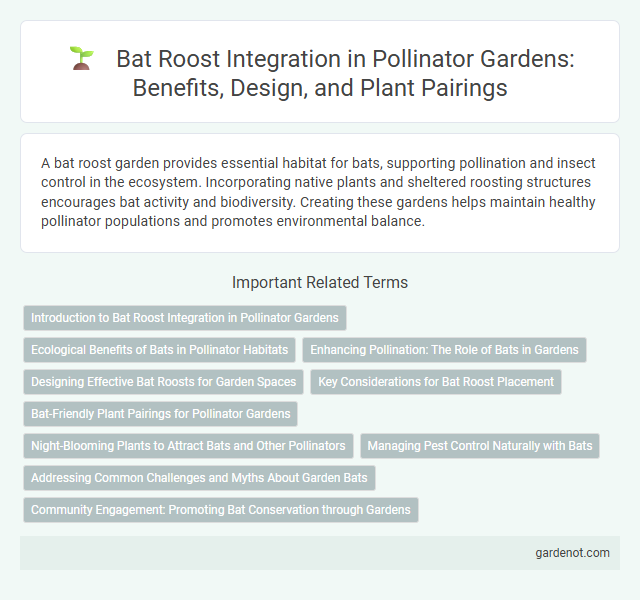A bat roost garden provides essential habitat for bats, supporting pollination and insect control in the ecosystem. Incorporating native plants and sheltered roosting structures encourages bat activity and biodiversity. Creating these gardens helps maintain healthy pollinator populations and promotes environmental balance.
Introduction to Bat Roost Integration in Pollinator Gardens
Bat roost integration in pollinator gardens enhances biodiversity by providing essential habitat for insect-eating bats, which naturally control pest populations. Designing bat-friendly structures within pollinator gardens encourages bat activity, boosting nocturnal pollination and improving overall ecosystem health. Incorporating native plants and water sources near bat roosts supports both bat and pollinator populations, creating a balanced and sustainable garden environment.
Ecological Benefits of Bats in Pollinator Habitats
Bat roost gardens provide critical habitat that supports bat populations, which play a vital role in pollinator ecosystems by facilitating the pollination of night-blooming plants and controlling insect populations. Bats contribute to biodiversity by enhancing the reproductive success of various flowering plants, including key agricultural crops like bananas, mangoes, and agave. Their ecological benefits include promoting healthier ecosystems, increasing plant diversity, and supporting sustainable pollination services essential for maintaining balanced pollinator habitats.
Enhancing Pollination: The Role of Bats in Gardens
Bat roost gardens significantly boost pollination by providing essential habitats for nectar-feeding bats, which are vital pollinators for many nocturnal plants. These gardens support biodiversity and increase fruit and seed production by facilitating bat movement and feeding activities. Integrating bat-friendly plants such as agave and night-blooming flowers optimizes pollination services in gardens.
Designing Effective Bat Roosts for Garden Spaces
Designing effective bat roosts for garden spaces involves selecting materials that provide insulation and moisture control, such as untreated wood or bat boxes with narrow slits to mimic natural crevices. Placement is critical, with roosts ideally positioned 10-15 feet above ground in quiet, shaded areas to protect bats from predators and extreme weather. Incorporating native plants that attract insects enhances the habitat, supporting a sustainable ecosystem for pollinators and contributing to natural pest control.
Key Considerations for Bat Roost Placement
Bat roost gardens thrive when placed in locations with minimal light pollution and proximity to water sources, ensuring bats can navigate and hydrate easily. Ideal roost sites include mature trees with exfoliating bark or purpose-built bat boxes installed at least 12 feet above ground to protect from predators. Selecting a site away from heavy human activity and ensuring ample insect populations nearby supports healthy bat foraging and sheltering behavior.
Bat-Friendly Plant Pairings for Pollinator Gardens
Bat roost gardens benefit from plant pairings that provide both nectar sources and roosting habitats, such as night-blooming flowers like evening primrose and native wild ginger. Incorporating tall grasses or shrubs like elderberry and silky dogwood supports bat shelter while attracting moths and other nocturnal pollinators. These bat-friendly plant combinations enhance ecosystem health by boosting pollination rates and increasing biodiversity within pollinator gardens.
Night-Blooming Plants to Attract Bats and Other Pollinators
Night-blooming plants such as evening primrose, moonflower, and night-blooming jasmine are essential in a bat roost garden to attract nocturnal pollinators like bats, moths, and certain beetles. These plants release strong fragrances and produce ample nectar after dusk, creating a rich food source that supports bat populations critical for pollination and insect control. Incorporating native species adapted to the local climate enhances ecological balance and promotes increased biodiversity within the garden ecosystem.
Managing Pest Control Naturally with Bats
Bat roost gardens provide a natural pest control solution by attracting insectivorous bats that consume vast quantities of agricultural pests, reducing the need for chemical pesticides. These gardens incorporate native plants and safe roosting habitats that support bat populations while promoting biodiversity. Implementing bat-friendly features such as bat houses can enhance pest management naturally, contributing to healthier, more sustainable ecosystems.
Addressing Common Challenges and Myths About Garden Bats
Bat roost gardens provide essential habitat for bats, supporting pollination and insect control while addressing common misconceptions that bats are dangerous or unclean. Educating gardeners about bat behavior and benefits dispels myths and encourages installing bat boxes and native plants to attract and sustain bat populations. Properly designed bat roost gardens enhance biodiversity and promote ecosystem health by offering safe roosting sites and diverse floral resources.
Community Engagement: Promoting Bat Conservation through Gardens
Bat roost gardens play a crucial role in community engagement by raising awareness about bat conservation and fostering local stewardship. These gardens provide essential habitats that support pollinators, which are vital for ecosystem health and biodiversity. Educational programs and volunteer opportunities centered around bat roost gardens empower residents to participate in habitat preservation, enhancing both environmental and community well-being.
Bat roost garden Infographic

 gardenot.com
gardenot.com